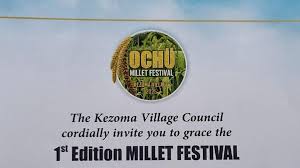
Kezoma Village in Nagaland to Host Inaugural Ochü Millet Festival

 :
| Updated On: 28-Aug-2025 @ 11:40 am
:
| Updated On: 28-Aug-2025 @ 11:40 amSHARE
Nagaland’s Kezoma village in Kohima district is set to host the first-ever Ochü Millet Festival on August 30 at the village ground. The festival marks a significant cultural and agricultural revival, jointly organised by the Kezoma Village Council, in collaboration with the Department of Agriculture and the Department of Tourism, Government of Nagaland. The event will be graced by Y. Vikheho Swu, President of NDPP Agri & Allied Organization and Managing Director of Okusa Toyota, as the special guest.
The Ochü Millet Festival will showcase millets and organic vegetables grown by the villagers, reflecting the community’s traditional farming practices and commitment to organic cultivation. The millet featured at the festival was harvested in July 2025, and will be put up for sale along with other produce. Various activities have been planned to engage villagers, farmers, and visitors, making the event a platform not only for cultural celebration but also for promoting agriculture and local entrepreneurship.
Millet holds deep cultural and ritualistic significance for the people of Kezoma. Historically, the community celebrated the crop’s harvest through the traditional Chünyi Festival. This festival carried both spiritual and agricultural meaning, and it played a central role in village life. The Chünyi celebration typically lasted two days. On the first day, called Kide (or Kizie), villagers performed sacred rituals and offered the first yield of millet to the spirits as a mark of reverence and thanksgiving. The second day, known as Kreuo zha, was observed as a day of rest and celebration, when the community came together to rejoice after the harvest.
The Chünyi festival was also associated with agricultural beliefs. It was considered to have the power to invite rainfall, which was crucial for paddy cultivation. In fact, historical accounts suggest that even neighbouring villages would request the people of Kezoma to perform Chünyi prayers to invoke rain on their behalf. Such practices highlight how millet was not only a staple crop but also central to the spiritual and ecological worldview of the community.
Traditionally, Chünyi celebrations also included unique forms of communal feasting. Each household would slaughter either a dog or a piglet as part of the ritual, sharing the meat among family members and neighbours. This act was symbolic of replenishing strength after the hard work of harvesting. While many of these customs have faded over the years due to changes in lifestyle and cultural adaptation, the essence of the celebration continues to live on in the memories of the people.
The introduction of the Ochü Millet Festival represents a conscious effort to revive and preserve Kezoma’s heritage. The organisers emphasised that the event is not just a cultural gathering but also a step toward safeguarding traditional knowledge and ensuring that younger generations remain connected to their roots. By highlighting millet, the festival seeks to promote it as a nutritious, climate-resilient, and sustainable crop, aligning with global calls to revive millets for food security.
In essence, the festival blends tradition with modern agricultural promotion, creating a platform to celebrate Kezoma’s identity, encourage millet cultivation, and pass on the rich cultural heritage to future generations.